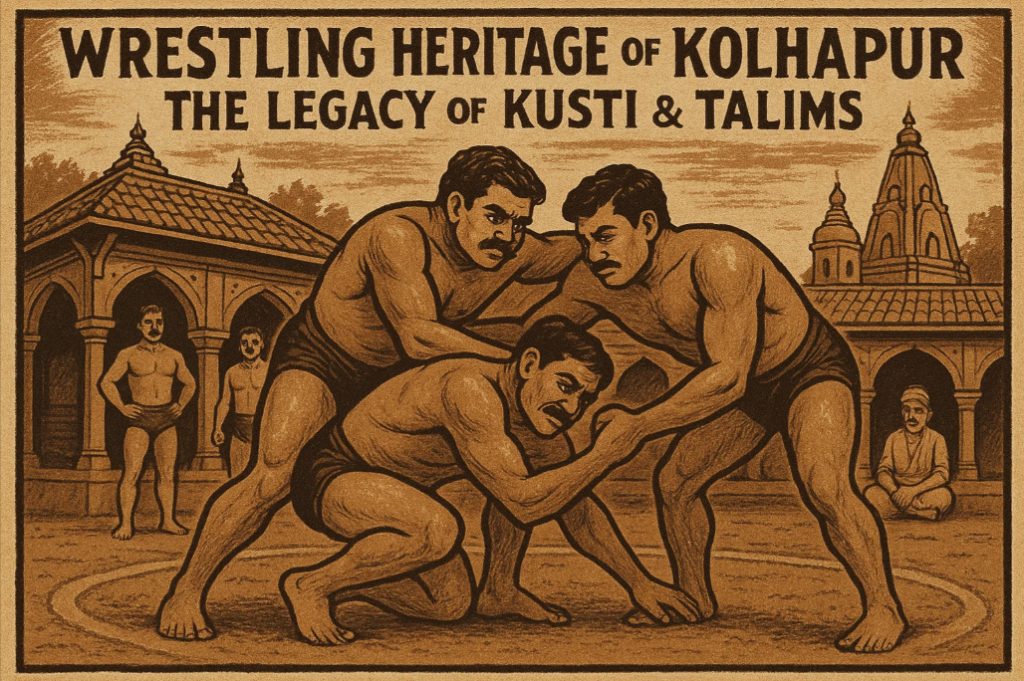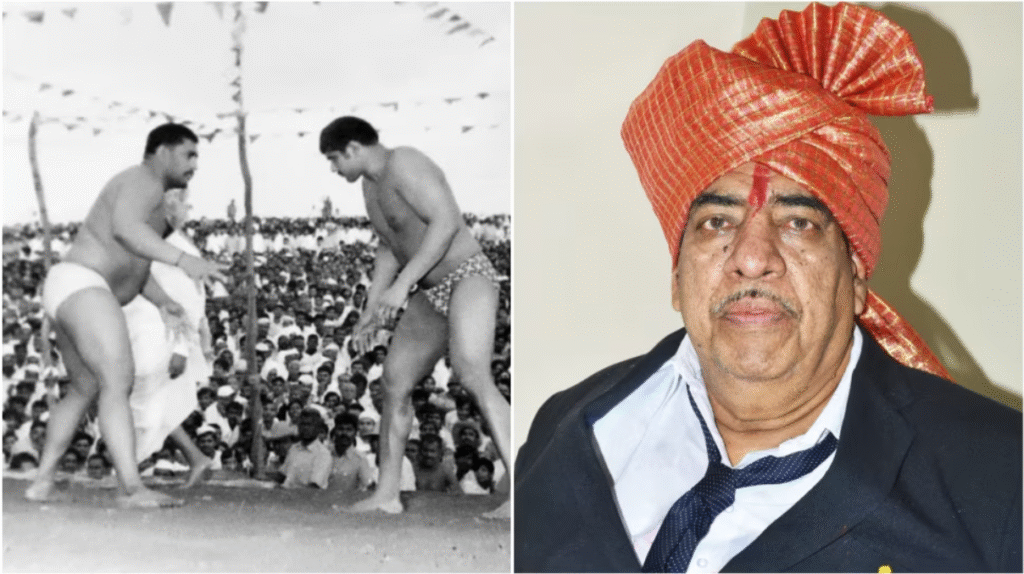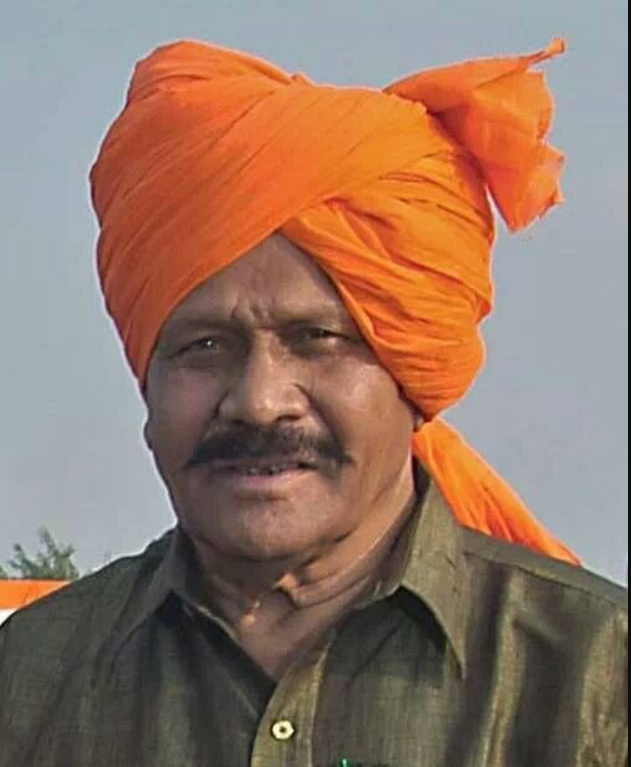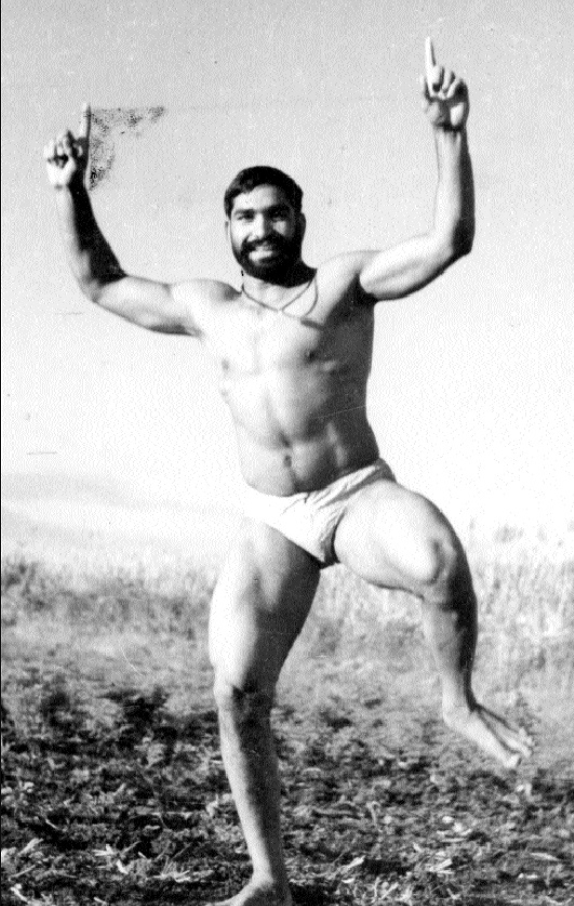Introduction: Where the Soil Breathes Legends – Kolhapur’s Unmatched Kusti Legacy
In the heart of Maharashtra lies Kolhapur, a city that resonates with tales of valor, regal history, and a culinary tradition famed for its fiery flavors. Yet, perhaps no other aspect defines Kolhapur’s identity as profoundly as its deep-rooted Wrestling Heritage of Kolhapur. Here, wrestling, or ‘Kusti’ as it’s locally known, is not merely a sport; it’s a way of life, a spiritual discipline, and an inseparable part of the district’s cultural DNA. The raw power, unwavering determination, and sheer grit seen in the ‘akhadas’ (wrestling arenas) and ‘talims’ (traditional wrestling schools) reflect the very spirit of Kolhapur.
This comprehensive exploration will take you on a journey through the glorious Wrestling Heritage of Kolhapur, tracing the historical threads of Kusti from its royal patronage to its modern-day resurgence. We will delve into the rigorous training regimens within the traditional ‘talims,’ shed light on the legendary ‘pehlwans’ (wrestlers) who have brought glory to the region, and understand how this ancient martial art continues to shape the social, cultural, and even economic fabric of Kolhapur. Whether you’re a sports enthusiast, a history buff, or simply curious about the unique essence of Kolhapur, this article will unveil the unparalleled legacy of Kusti and Talims that continues to thrive in this vibrant district.

I. The Deep Roots: Tracing the History of Kolhapur Wrestling
The Wrestling Heritage of Kolhapur is not a recent phenomenon; its roots stretch back centuries, intertwining with the region’s royal and martial history. The fertile lands and the martial prowess of its people created a natural breeding ground for wrestling.
A. Royal Patronage and the Maratha Era: The real impetus to Kolhapur’s wrestling culture came with the Maratha Empire, and particularly under the patronage of its dynamic rulers. Wrestling was seen not just as a sport, but as a vital component of martial training, fostering physical strength, discipline, and strategic thinking – qualities essential for warfare.
- Chhatrapati Shivaji Maharaj: While records directly linking him to Kolhapur’s wrestling are scant, his emphasis on building a strong, physically fit army and encouraging martial arts undeniably set a precedent that later Maratha rulers, including those from Kolhapur, would follow.
- Chhatrapati Shahu Maharaj (Kolhapur): The 20th century saw the true golden age of Wrestling Heritage of Kolhapur under the visionary patronage of Chhatrapati Shahu Maharaj (1874-1922). A social reformer and a passionate patron of the arts and sports, Shahu Maharaj recognized wrestling’s potential beyond just physical training.
- Promotion of ‘Kusti’: He personally encouraged wrestlers from all castes and communities, dismantling traditional barriers and making wrestling accessible. He offered financial support, land, and patronage to talented pehlwans.
- Establishment of Talims: Shahu Maharaj founded and supported numerous ‘talims’ (wrestling schools) where aspiring wrestlers could live, train, and study under expert ‘ustads’ (gurus). He even invited famous wrestlers from across India, including Punjab, to come and train in Kolhapur, enriching its techniques and reputation.
- Organizing ‘Kusti Dangals’: He organized grand wrestling tournaments (‘dangals’) that attracted wrestlers and spectators from far and wide, offering significant prizes and recognition, further cementing Kolhapur’s reputation as the “Mecca of Indian Wrestling.”
This royal backing elevated Kusti from a mere pastime to a revered tradition, drawing in talent and resources, and establishing a unique identity for the Wrestling Heritage of Kolhapur.
B. The Blend of Styles: Kolhapur wrestling developed as a unique blend, incorporating elements of traditional Indian wrestling (mostly ‘Pehlwani’ or ‘Kushti’) with influences from different regions brought in by invited wrestlers. This fusion of techniques, coupled with rigorous training, allowed Kolhapur pehlwans to develop a distinct style known for its brute strength, endurance, and powerful techniques.
II. The Sanctum of Strength: Understanding the ‘Talim’ System
At the very heart of the Wrestling Heritage of Kolhapur lies the ‘Talim’ (तालीम), which literally means ‘training’ or ‘school’. These are not just gyms; they are traditional wrestling academies, often residential, where young aspirants dedicate their lives to the sport and the strict discipline it demands.
A. Architecture and Atmosphere of a Talim: A traditional ‘talim’ is typically a large, open-air or semi-covered area with a central ‘akhada’ (अखाडा) – the wrestling pit.
- The Akhada: This is a specially prepared circular pit filled with fine, sifted earth (‘mati’ माती). The soil is meticulously prepared daily by mixing it with oil, turmeric, buttermilk, and sometimes even red ochre (geru), believed to have antiseptic and cooling properties. Wrestlers warm up, train, and wrestle in this pit. The unique preparation of the ‘mati’ is central to the Kolhapur wrestling tradition, providing a soft but firm surface that protects joints and allows for intricate maneuvers.
- Living Quarters: Many talims have attached dormitories or rooms where the ‘pehlwans’ live communally, fostering a brotherhood (akin to a ‘gurukul’ system).
- Gymnasium Equipment: Beyond the akhada, talims are equipped with traditional Indian strength-training equipment:
- Nals (नळ): Stone or concrete rings of varying weights, used for shoulder and arm strength.
- Gadas (गदा): Heavy wooden maces (like Lord Hanuman’s mace), used for developing core strength, grip, and explosive power. The ‘gada’ is an iconic symbol of pehlwani strength.
- Mugdar (मुग्दर): Lighter wooden clubs for dynamic swings and shoulder rotation.
- Joris (जोरीस): Wooden dumbbells for arm strength.
- Log-pulling and Stone-lifting: Traditional exercises for brute strength and endurance.
B. The Daily Routine of a Kolhapur Pehlwan: Life in a ‘talim’ is characterized by strict discipline, physical rigor, and a focus on holistic development.
- Early Morning (4:00-5:00 AM): The day begins before dawn with prayers and warm-up exercises.
- Akhada Training (First Session): This involves intense wrestling drills, practicing moves, grappling, and sparring sessions in the ‘mati’. This is followed by specialized strength and endurance exercises like ‘dands’ (push-ups), ‘baithaks’ (squats), rope climbing, and running.
- Diet: Post-training, pehlwans consume a highly nutritious diet. Traditionally, this includes:
- Milk: A large quantity, often mixed with almonds, ghee, and local herbs.
- Ghee (clarified butter): Consumed in significant amounts for energy and joint lubrication.
- Almonds & Walnuts: For protein and healthy fats.
- Dates & Jaggery: For energy.
- Sprouted Grains & Pulses: For protein.
- Chicken/Mutton (non-vegetarian diet): Many pehlwans are vegetarian, but those who are non-vegetarian consume specific types of meat for muscle building.
- Fruits and Vegetables: Essential for vitamins and minerals.
- The diet is carefully planned to fuel their intense physical regimen.
- Rest and Study: After breakfast, there’s a period for rest. Some talims also emphasize general education or religious studies.
- Afternoon Training (Second Session): This session might focus on specific strength training, technique refinement, or conditioning exercises.
- Evening: Light stretching, massage (malish), and an early dinner, followed by early sleep.
C. The Role of the ‘Ustad’: The ‘Ustad’ (गुरु), or guru, is the central figure in a ‘talim’. They are experienced, often retired, pehlwans who guide the younger generation.
- Mentor and Coach: They teach wrestling techniques, supervise training, and advise on diet and lifestyle.
- Life Guide: An Ustad also acts as a father figure, imparting moral values, discipline, and respect, shaping the character of the pehlwan. The bond between an Ustad and his disciples is sacred.
- Preserver of Tradition: Ustads are the custodians of the Wrestling Heritage of Kolhapur, passing down ancient knowledge and values.
The ‘talim’ system is fundamental to understanding why Wrestling Heritage of Kolhapur has endured, providing a structured, disciplined, and nurturing environment for aspiring champions.
III. Legendary Pehlwans: The Torchbearers of Kolhapur’s Wrestling Glory
The rich Wrestling Heritage of Kolhapur is best embodied by the formidable pehlwans who have emerged from its ‘talims’ and dominated wrestling arenas across India and beyond. Their names are etched in the annals of Indian sports history and are sources of immense pride for the district.
A. Early Legends & Shahu Maharaj’s Era: During Chhatrapati Shahu Maharaj’s time, Kolhapur became a melting pot of wrestling talent. Legends like:
- Ghulam Ghaus Khan: A renowned wrestler from Punjab who wrestled and trained in Kolhapur.
- Kallu Pehlwan: A formidable local champion.
- Haidarabadwala: Another top-tier wrestler whose presence contributed to Kolhapur’s reputation.
B. The Post-Independence Era & Beyond:
- Rustam-e-Hind Dadu Mama Chougle (1918-1991): One of the most revered names in Indian wrestling, Dadu Mama was a true giant. His strength and technique were legendary. He was famously known for never losing a single major bout in his career. His dedication and humility continue to inspire generations of wrestlers in Kolhapur.

- Hind Kesari Ganpatrao Andalkar (1928-2017): A recipient of the Arjuna Award (India’s prestigious sports honor) and a formidable wrestler known for his powerful moves and strategic thinking. He was a gold medalist at the 1962 Asian Games.

- Hind Kesari Maruti Mane (1939-2010): Another iconic figure, Maruti Mane was a powerful wrestler and a disciplined trainer. He also received the Arjuna Award and excelled at national and international levels.

- Hind Kesari Dinanath Singh (1927-2015): Though not originally from Kolhapur, he trained extensively there and is often associated with the Kolhapur style. He was a very influential figure in Indian wrestling.

- Hind Kesari Harishchandra Birajdar: A well-known pehlwan who achieved the Hind Kesari title, a highly coveted honor in Indian wrestling.

- Hind Kesari Vinod Chougle: Carrying forward the legacy of his family (related to Dadu Mama), Vinod Chougle was another prominent wrestler from Kolhapur who earned the Hind Kesari title.
- And many more…: Kolhapur has produced countless ‘Maharashtra Kesari’, ‘Hind Kesari’, and international medalists, consistently reaffirming the strength of its wrestling tradition.
These pehlwans are not just athletes; they are cultural heroes, epitomizing the values of strength, discipline, and perseverance that are central to the Wrestling Heritage of Kolhapur. Their exploits in the ‘akhadas’ continue to inspire young boys (and increasingly girls) to take up the sport.
IV. The Grand Spectacle: ‘Kusti Dangals’ and Their Significance
The ultimate showcase of the Wrestling Heritage of Kolhapur is the ‘Kusti Dangal’ (दंगल) – a grand wrestling tournament that draws massive crowds, often thousands strong. These events are more than just competitions; they are cultural festivals, social gatherings, and a vital part of the district’s annual calendar.
A. Structure of a Dangal:
- The Arena: Dangals are often held in large open fields, with temporary seating arrangements for spectators. The ‘akhada’ is meticulously prepared, often with great reverence.
- Types of Bouts: Bouts range from those involving young, aspiring pehlwans to highly anticipated matches between seasoned champions.
- Prizes: Winners receive cash prizes, often significant sums, and other rewards like silver or gold maces (gadas), which are highly symbolic.
- Commentary: The bouts are narrated by enthusiastic commentators who provide running commentary, historical anecdotes, and technical explanations, heightening the drama.
- Music and Festivities: Dangals are accompanied by traditional music, drumming, and a festive atmosphere, reflecting the celebratory nature of the event.
B. Social and Cultural Significance:
- Community Cohesion: Dangals bring together people from all walks of life, transcending social and economic barriers. They foster a sense of community pride and shared heritage.
- Platform for Talent: They provide a crucial platform for young pehlwans to showcase their skills, gain recognition, and attract patronage.
- Preservation of Tradition: The very act of organizing and attending dangals helps to preserve the centuries-old tradition of Kusti, ensuring its continuity.
- Economic Impact: Dangals stimulate the local economy, attracting visitors, supporting local businesses, and providing income for organizers and participants.
- Symbol of Strength and Pride: Winning a major dangal in Kolhapur, especially one for the ‘Hind Kesari’ or ‘Maharashtra Kesari’ title, brings immense prestige not just to the individual pehlwan but also to their ‘talim’ and village.
The grandeur of a Kolhapur dangal is a powerful testament to the enduring passion for the Wrestling Heritage of Kolhapur, showcasing its blend of sport, tradition, and community spirit.
V. The Nuances of Kusti: Techniques, Diet, and Lifestyle
The Wrestling Heritage of Kolhapur is built on a specific methodology that combines rigorous training, a highly specialized diet, and a disciplined lifestyle.
A. Key Kusti Techniques: Kusti involves a blend of grappling, throws, and holds, often emphasizing strength and endurance. Some common techniques include:
- Dhobi Pachhad (Laundry Throw): A classic throw where the opponent is lifted and slammed onto their back.
- Dhank (Hip Throw): Using the hips to throw the opponent over.
- Kandawala (Shoulder Hold): A powerful hold applied to the opponent’s shoulder.
- Pat (Leg Catch): Catching the opponent’s leg to bring them down.
- Kasrat (Exercises): The fundamental conditioning exercises like ‘dands’ (push-ups with a unique motion) and ‘baithaks’ (squats with arm swings), which are performed in high repetitions to build stamina and strength.
B. The ‘Pehlwan’ Diet: As mentioned earlier, the diet of a Kolhapur pehlwan is legendary. It’s a high-calorie, high-protein regimen meticulously designed to support immense physical exertion and muscle growth. Key elements often include:
- Pure Ghee (Clarified Butter): Often consumed with milk, rotis, or rice.
- Almonds and other nuts: Soaked and peeled, then ground into a paste or consumed raw.
- Milk: Large quantities, often flavored with saffron, cardamom, and jaggery.
- Sprouted Grains and Pulses: Such as chickpeas, green gram, for plant-based protein.
- Traditional Sweets: Made with jaggery, nuts, and ghee for concentrated energy.
- Chicken/Mutton: For non-vegetarian pehlwans, specific preparations (often boiled or lightly spiced) are consumed.
- Fresh Fruits and Vegetables: Essential for vitamins, minerals, and fiber.
- Avoidance: Strict avoidance of processed foods, refined sugars, excessive spices, and alcohol.
C. Disciplined Lifestyle: A pehlwan’s life is about much more than just physical training. It involves a strict code of conduct:
- Brahmacharya (Celibacy): Many pehlwans practice celibacy for a period, believing it conserves energy and mental focus.
- Early to Bed, Early to Rise: Crucial for recovery and maximizing training time.
- Respect for Elders and Ustads: A deep sense of humility and respect for their gurus and seniors.
- Simple Living: Minimalist lifestyle focused on training, diet, and rest.
- Meditation and Prayer: Many engage in spiritual practices for mental strength and focus.
This holistic approach is what transforms an ordinary individual into a formidable pehlwan and is a defining characteristic of the Wrestling Heritage of Kolhapur.
VI. Modern Challenges and the Future of Kolhapur Wrestling
Despite its glorious past and deep cultural roots, the Wrestling Heritage of Kolhapur faces several challenges in the modern era.
A. Financial Constraints:
- Lack of Sponsorship: Traditional wrestling often struggles to attract large corporate sponsorships compared to more commercially viable sports.
- Pehlwans’ Livelihood: Many aspiring pehlwans come from humble backgrounds. Sustaining the rigorous diet and training without adequate financial support is a significant hurdle. State and central government support, though present, is often perceived as insufficient.
- Maintenance of Talims: Maintaining traditional ‘talims’ and their unique ‘akhadas’ is costly, and many struggle for funds.
B. Changing Aspirations and Competition:
- Shift to Olympic Wrestling: The emphasis on Olympic-style wrestling (mat wrestling) for international recognition means traditional ‘mati’ wrestling (Kusti) often takes a backseat. Many pehlwans are forced to adapt to mat wrestling, which requires different techniques and conditioning.
- Attraction of Other Sports: Young talent sometimes gravitates towards sports with clearer career paths, higher financial rewards, or global appeal (e.g., cricket, football, kabaddi).
- Lack of Infrastructure for Mat Wrestling: While Kolhapur excels in ‘mati’ wrestling, its infrastructure for modern mat wrestling, though improving, still needs significant upgrades to produce Olympic-level talent consistently.
C. Health and Nutritional Issues:
- Doping: The pressure to perform and achieve titles sometimes leads to the unfortunate use of performance-enhancing drugs, a problem faced globally in many sports, including wrestling.
- Dietary Shifts: Access to traditional, organic, and highly nutritious food for pehlwans can be challenging and expensive.
D. Preservation of Traditional Knowledge:
- Decline of Traditional Ustads: Fewer experienced ‘ustads’ are willing or able to dedicate their lives to training young pehlwans without sufficient support.
- Modernization vs. Tradition: Striking a balance between preserving the authentic Wrestling Heritage of Kolhapur and adapting to modern sporting demands is a delicate challenge.
E. Government and Public Support:
- Scheme Implementation: Effective implementation of government schemes for wrestlers (e.g., scholarships, coaching, job reservations) is crucial.
- Public Awareness: While Kolhapur has a strong fan base, continued public awareness campaigns are needed to inspire the next generation and attract more support.
F. Female Participation:
- While wrestling has traditionally been male-dominated, there’s a growing trend of female wrestlers. Kolhapur has started to see more women in the akhadas, but infrastructure and cultural support for them still need to grow to match their male counterparts.
Despite these challenges, there is optimism. The deep-seated pride in the Wrestling Heritage of Kolhapur among locals, the dedication of surviving ‘talims’, and the efforts of former pehlwans and local bodies are ensuring that the legacy endures. Annual dangals continue to attract crowds, and stories of legendary pehlwans are passed down through generations.
VII. The Enduring Legacy: Why Kolhapur Wrestling Matters
The Wrestling Heritage of Kolhapur is more than just a collection of historical facts or sporting achievements. It’s a living, breathing tradition that continues to shape the district in profound ways.
- Cultural Identity: Kusti is intrinsically linked to Kolhapur’s identity. It represents strength, courage, self-discipline, and a connection to the land and its history. The ‘Kolhapuri Pheta’ (turban) and ‘Kolhapuri Chappal’ are often seen alongside symbols of wrestling.
- Physical and Mental Discipline: The ‘talim’ system instills unparalleled physical and mental discipline, character building, and respect for elders and opponents. These values extend beyond the akhada into daily life.
- Social Cohesion: Wrestling provides a common ground for people from all social strata. Dangals, in particular, are platforms for communal bonding and celebration.
- Inspiration: The tales of legendary Kolhapur pehlwans continue to inspire young boys and girls, not just to pursue wrestling but to cultivate a disciplined and healthy lifestyle.
- Tourism: The unique wrestling culture attracts tourists and researchers, contributing to Kolhapur’s cultural tourism.
- Contribution to National Sports: Kolhapur has consistently contributed talented wrestlers to national and international competitions, strengthening India’s presence in the sport.
The preservation of this heritage is a collective responsibility, requiring continued support from the government, sports bodies, local communities, and the citizens of Kolhapur. Every ‘Akhada’, every ‘Ustad’, and every aspiring ‘Pehlwan’ embodies this unique and precious legacy.
Conclusion: Kolhapur – The Undisputed Home of Kusti
The Wrestling Heritage of Kolhapur: The Legacy of Kusti & Talims stands as a magnificent testament to a bygone era of royal patronage and traditional martial arts, yet it remains a vibrant, living tradition that continues to thrive in the modern age. It is a story of raw strength, unyielding discipline, and profound respect for the ‘guru-shishya parampara’ (teacher-disciple tradition).
From the meticulous preparation of the hallowed ‘mati’ in the ‘akhadas’ to the legendary feats of pehlwans like Dadu Mama Chougle and Maruti Mane, Kolhapur’s contribution to Indian wrestling is unparalleled. While facing contemporary challenges, the passion for Kusti burns bright, sustained by dedicated ‘ustads’, aspiring young wrestlers, and the unwavering pride of the Kolhapuri people.
For anyone seeking to understand the true spirit of Kolhapur, one must look no further than its wrestling pits. Here, the sweat, grit, and cheers echo through time, preserving a unique cultural identity and inspiring generations. The Wrestling Heritage of Kolhapur is not just a legacy to be cherished; it is a powerful force that continues to define, empower, and inspire. May the spirit of Kusti forever flourish in the land of champions.
Read this : https://kolhapurdistrict.in/news
Read This : https://sanglidistrict.in/
Read This : https://sataradistrict.in/
🌐 The Power of Our District PR Ecosystem
We are not just a media agency—we are building an entire district-level digital infrastructure with:
Each site provides:
- SEO blog space
- Video PR hosting
- Local business features
- Event coverage
- News updates


